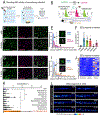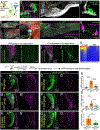Enteroendocrine cells sense bacterial tryptophan catabolites to activate enteric and vagal neuronal pathways
- PMID: 33352109
- PMCID: PMC7997396
- DOI: 10.1016/j.chom.2020.11.011
Enteroendocrine cells sense bacterial tryptophan catabolites to activate enteric and vagal neuronal pathways
Abstract
The intestinal epithelium senses nutritional and microbial stimuli using epithelial sensory enteroendocrine cells (EEC). EECs communicate nutritional information to the nervous system, but whether they also relay signals from intestinal microbes remains unknown. Using in vivo real-time measurements of EEC and nervous system activity in zebrafish, we discovered that the bacteria Edwardsiella tarda activate EECs through the receptor transient receptor potential ankyrin A1 (Trpa1) and increase intestinal motility. Microbial, pharmacological, or optogenetic activation of Trpa1+EECs directly stimulates vagal sensory ganglia and activates cholinergic enteric neurons by secreting the neurotransmitter 5-hydroxytryptamine (5-HT). A subset of indole derivatives of tryptophan catabolism produced by E. tarda and other gut microbes activates zebrafish EEC Trpa1 signaling. These catabolites also directly stimulate human and mouse Trpa1 and intestinal 5-HT secretion. These results establish a molecular pathway by which EECs regulate enteric and vagal neuronal pathways in response to microbial signals.
Keywords: Danio rerio; bacterial tryptophan catabolism; enteroendocrine cells; gut microbes; gut-brain axis communication; indole; indole-3-carboxaldehyde; intestinal peristalsis; serotonin.
Copyright © 2020 Elsevier Inc. All rights reserved.
Conflict of interest statement
Declaration of interests The authors declare no competing interests.
Figures







Comment in
-
Tryptophan metabolites get the gut moving.Cell Host Microbe. 2021 Feb 10;29(2):145-147. doi: 10.1016/j.chom.2021.01.009. Cell Host Microbe. 2021. PMID: 33571438
References
-
- ABAYNEH T, COLQUHOUN DJ & SORUM H 2013. Edwardsiella piscicida sp. nov., a novel species pathogenic to fish. J Appl Microbiol, 114, 644–54. - PubMed
-
- BAUTISTA DM, JORDT SE, NIKAI T, TSURUDA PR, READ AJ, POBLETE J, YAMOAH EN, BASBAUM AI & JULIUS D 2006. TRPA1 mediates the inflammatory actions of environmental irritants and proalgesic agents. Cell, 124, 1269–82. - PubMed
Publication types
MeSH terms
Substances
Grants and funding
LinkOut - more resources
Full Text Sources
Other Literature Sources
Molecular Biology Databases
Research Materials

